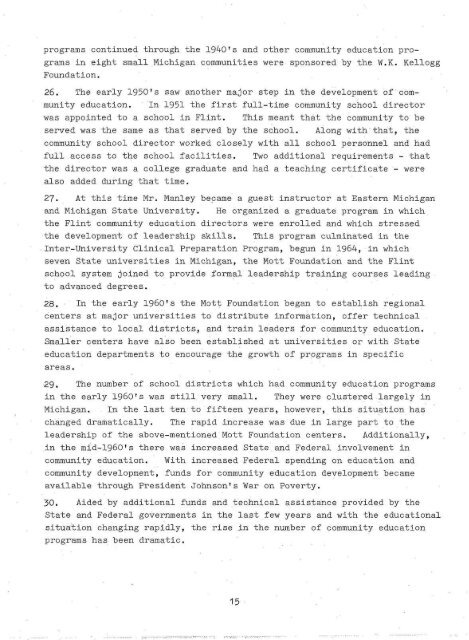BUILDING FOR SCHOOL AND COMMUNITY - Kennedy Bibliothek
BUILDING FOR SCHOOL AND COMMUNITY - Kennedy Bibliothek
BUILDING FOR SCHOOL AND COMMUNITY - Kennedy Bibliothek
You also want an ePaper? Increase the reach of your titles
YUMPU automatically turns print PDFs into web optimized ePapers that Google loves.
programs continued through the 1940's and other community education programs<br />
in eight small Michigan communities were sponsored by the W.K. Kellogg<br />
Foundation.<br />
26. The early 1950's saw another major step in the development of community<br />
education. In 1951 the first full-time community school director<br />
was appointed to a school in Flint. This meant that the community to be<br />
served was the same as that served by the school. Along with that, the<br />
community school director worked closely with all school personnel and had<br />
full access to the school facilities. Two additional requirements - that<br />
the director was a college graduate and had a teaching certificate - were<br />
also added during that time.<br />
27. At this time Mr. Manley became a guest instructor at Eastern Michigan<br />
and Michigan State University. He organized a graduate program in which<br />
the Flint community education directors were enrolled and which stressed<br />
the development of leadership skills. This program culminated in the<br />
Inter-University Clinical Preparation Program, begun in 1964, in which<br />
seven State universities in Michigan, the Mott Foundation and the Flint<br />
school system joined to provide formal leadership training courses leading<br />
to advanced degrees.<br />
28. In the early 1960's the Mott Foundation began to establish regional<br />
centers at major universities to distribute information, offer technical<br />
assistance to local districts, and train leaders for community education.<br />
Smaller centers have also been established at universities or with State<br />
education departments to encourage the growth of programs in specific<br />
areas.<br />
29. The number of school districts which had community education programs<br />
in the early 1960's was still very small. They were clustered largely in<br />
Michigan. In the last ten to fifteen years, however, this situation has<br />
changed dramatically. The rapid increase was due in large part to the<br />
leadership of the above-mentioned Mott Foundation centers. Additionally,<br />
in the mid-1960's there was increased State and Federal involvement in<br />
community education. With increased Federal spending on education and<br />
community development, funds for community education development became<br />
available through President Johnson's War on Poverty.<br />
30. Aided by additional funds and technical assistance provided by the<br />
State and Federal governments in the last few years and with the educational<br />
situation changing rapidly, the rise in the number of community education<br />
programs has been dramatic.<br />
15
















